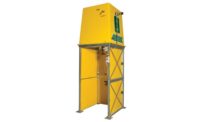The cold weather season is upon us, which means that outdoor job sites will face a new set of challenges. Emergency eyewashes and showers must continue to function no matter how low the temperature may drop. The ANSI/ISEA Z358.1 standard requires this equipment be protected from freezing temperatures when the threat of freezing is present.
When selecting showers and eyewashes for a freeze-prone job site, select a unit with electrical heat tracing. These units are thermostatically regulated and protect showers and eyewashes from freezing to temperatures as low as 50 degrees below zero. Most units will also have insulation, gaskets and an easy access protective shell to further shield the unit from the elements. Heat traced shower and eyewash combinations equipped with mechanical Freeze Protection valves offer added protection should there ever be a power outage.
It is important to note that electrically heat traced showers and eyewashes do not deliver tepid water to the user, they simply keep the unit operable in sub-freezing conditions. To provide tepid water the facility will need to provide a safe, suitable hot water system that can deliver the ANSI/ISEA Z358.1 recommended water temperature range of 60F-100F. Typically, this involves some type of commercial hot water heater along with an ASSE 1071 thermostatic mixing valve.
For outside jobs on the go, there are tepid water equipment options to keep the site eyewash compliant. Look for a 20-gallon capacity tank, which is among the highest capacity units in the portable eyewash category. You want an insulated, electrically freeze-protected jacket that will prevent the unit from freezing and will deliver tepid water on job sites experiencing temperatures as low as -10 degrees. These portable solutions provide 15 minutes of continuous flow as required by ANSI/ISEA Z358.1.
For moderately cold climates, freeze protection valves can be installed on existing equipment or included on new equipment to help prevent the shower or eyewash from freezing and rendering it inoperable. When a freeze protection valve is in place, it detects drops in water temperature and keeps water flowing to prevent freeze up.
As a reminder, when looking for safety and emergency equipment for your freeze-prone job sites, make sure to purchase equipment that meets the ANSI/ISEA Z358.1 standard.
Source: Speakman - https://speakman.com/






